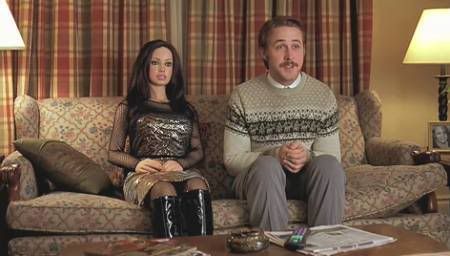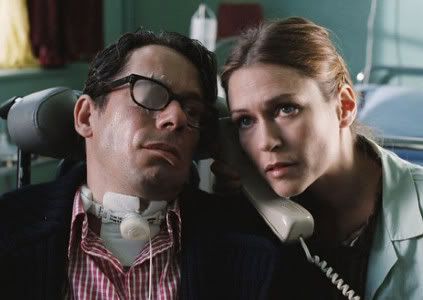
Lars and the Real Girl is a 2007 movie directed by Craig Gillespie and written by Karen Oliver. The movie is about Lars, played by Ryan Gosling, whose sterile existence, is about to have a drastic change. Lars is a loveable social misfit who lives in the room connected to the family garage. His brother, Gus, and his wife Karin, live in the main house. Early on you see that Karin does her best to make Lars feel included, much to Lars' dismay. His life consists of getting ready in the morning to head out to work and heading right back into his home as soon as its done. Anything else is asking too much of him.
Lars' home world is made up of bleak whites and emptiness, while his family, tends to live among more color. His world is full of people trying to break through the barrier he has put up. His family, co-workers, and friends, do their best to show they want to include him. This seems to go right over his head. He doesn't like people to touch him, and fears social interaction. His sister-in-law repeatedly tries to get Lars to come to dinner. Eventually he accepts and tells his family that he will be bringing a female guest.
Then the reality of the matter hits. His female friend is Bianca, a Real Doll, and his family is shocked to say the least. His brother panics and can't even begin to grasp the thought of what this all means. Karin, on the other hand, does her best to be understanding, and from early on, plays along with the fact that Bianca is a real person, and that she obviously matters to Lars. This movie works solely on the basis that Lars lives in a world that is VERY understanding. Not to mention that the actors play it very straight.
Ryan Gosling plays Lars to perfection. You get a portrait of a young man holding back, but, who's real self is just hiding below the surface, waiting to break out. Emily Mortimer, and Paul Schneider, who play his sister-in-law, and brother, do a fantastic job of being appalled and understanding in their roles. Mortimer makes the character of Karin, sweet, understanding, and just the right touch naive. While Schneider, clearly playing the part of the disturbed brother, plays his role believable enough that he serves as the voice of doubt in the whole matter.
Along the way, Lars' family tricks him into visiting the local doctor/psychologist. This role is played with the right amount of subtlety by Patricia Clarkson. She is supposed to check on Bianca's health. All the while, getting more insight into what has prompted Lars to take up creating this persona, Bianca, and if it's in fact a sign of mental illness. The towns reaction to Lars new friend is surprising to say the least, but, helps to solidify Bianca as a character. I went into this movie being a non-believer as well. Quick to judge Lars, and poke fun at him. This is where the movie tricks you, because, in the end, the viewer, begins to believe as well.
I have to give it to the scriptwriter for being able to create this world where people are more tolerant and understanding of what is different from them. I went into this movie ready to ridicule the Lars character, and walked away with feelings for "someone" I had no idea I would care for in the end.


